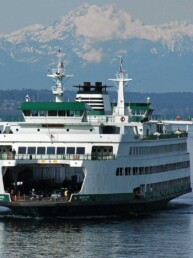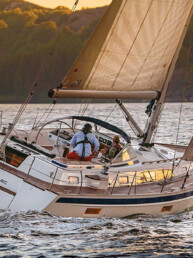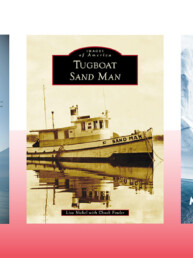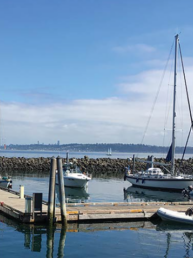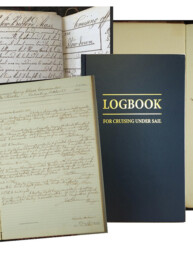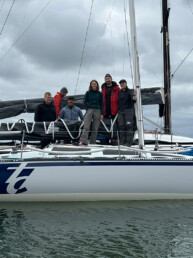After a busy spring and early summer, I was finally on the plane to France for my three-race “Red Ruby Tour, Summer 2024 Edition.” After so much preparation, planning, logistics, trying to get things done, and entering races from halfway around the world, it would be so great to just go sailing again.
My train from Paris to Auray was fast and on time, with barely a moment for my jet-lagged brain to go through my lists one more time before arriving in Brittany. I had just two days to organize the boat, put the extra gear in storage, prepare the sails, and start looking at the weather and tides. My partner for this 270-mile race was Olivier LeDiouris, a local who spent 20 years in San Francisco working for Oracle. He is a very good sailor who once raced with the legendary Eric Tabarly. Of course his French is excellent, useful for reading race documents and spotting things I might miss. His English is also very good, so communicating on the boat was no problem. He is the same age and in the same stage of life as I am, so we have a lot in common. He and his wife sailed their Cheoy Lee 44 to the South Pacific and back, and I knew we would have a lot of fascinating discussions around that.
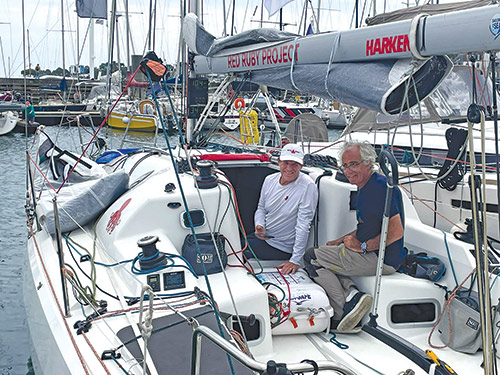
The race course is from La Trinité-sur-Mer on the Brittany coast to Wolf Rock off the western tip of England, finishing in Cherbourg in northern Normandy. With a mostly northwest wind, it should be upwind after exiting the Gulf of Morbihan and going up the Brittany coast to Ouessant, then across the English Channel, then back across the channel eastward via Eddystone Lighthouse, past the current-infested Casquets rocks and Raz Blanchard strait to Cherbourg. It’s 270 miles as the crow flies, but much longer because it is mostly upwind and downwind, with some reaching in the middle. Our fleet of 11 doublehanders was not the biggest, but it included a few of the top French boats that we always struggle to beat.
When race day came, we had a reaching start, which should have been straightforward, but I got the positioning a bit wrong and we had to circle around at the last second. Soon we were on our way to La Teignouse lighthouse, just behind the top group. After 10 miles of reaching, we turned upwind for the 50-mile slog to Penmarch, the first major point. We found some good speed and positioning, and as the first night fell we were just behind Timeline for the lead, going upwind in 10 knots of wind, with Arthritis Foundation, Abracadabra 2, and Kestrel just behind. So far, so good! We both tried to get some rest that evening, because the next day was going to be tricky—negotiating the dreaded Raz de Sein stretch of water and Ouessant Island.
As day two dawned, most of the fleet was staying on a starboard tack, going offshore in anticipation of a left shift. We chose a more inshore route, eventually going inside the islands at Raz de Sein. Kestrel followed us, but we lost track of the rest of our group as they stayed offshore. Things looked good during that morning, with positive current and decent wind. But with the afternoon came current against us and very light wind. Did we blow it with our inshore move?
Eventually we picked up the race tracker app on our phone, and we could see that the offshore group also had light wind. They were more upwind of us with the left shift, but we hoped that there would eventually be a right shift. We sailed fast all afternoon and into the night, crossing the English Channel on a port tack. As we approached the Cornwall coast in the breaking light, we finally started to get headed. An hour later we tacked, now laying Wolf Rock on a starboard tack. Our move paid off. We rounded the lighthouse first in our class, with our sistership Kestrel about 4 miles behind, and the others just behind it.
The reach to Lizard Point and Eddystone Lighthouse was uneventful. We were flying the Code Zero in 10 to 17 knots, great conditions for a Sun Fast 3300. As we approached Eddystone, I rigged the big A2 kite. The breeze had built to 20 knots and we took off onto the final 120-mile leg to Cherbourg. The run started out promising, but the wind soon died and we switched to the smaller A1.5. We could see Kestrel close behind, but we lost track of the others as they jibed to the south.
We had to choose how to manage passage of the Channel Islands and the Casquets TSS exclusion zone (an area of high shipping traffic that is off-limits). There are essentially three possible routes to the finish: north of the TSS (more miles away from the fleet), south of the TSS but north of Alderney Island (shortest, but lots of negative current), and south of Alderney (which looked pretty radical, but potentially offered current relief). Neither Olivier nor I had a tremendous amount of experience in this place, and we were both pretty tired after two and a half days of hard sailing. Further complicating matters, we couldn’t see any of the competition on AIS and we had no cell phone data, so no tracker info. Accordingly, we decided to take the middle route.
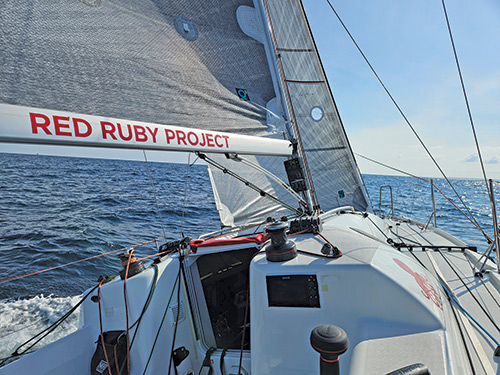
The next five hours were spent running in 9 to 12 knots, jibing back and forth against the current and making progress toward the finish, which was now only 40 miles ahead. Little did we know, our competition was digging way south, getting current shelter in the lee of Alderney, and making up miles quickly. When we finally got a cell signal, we could see that we were in trouble. The three trailing boats were only a couple of miles behind. As dawn broke, we could finally see their spinnakers coming from the south.
We crossed Raz Blanchard in the final miles into Cherbourg, and all four lead boats were within a mile of each other. We were still in the lead, but there was a problem: We owed all three boats time under the IRC handicap system. We held the lead for the tight reach into Cherbourg Harbour, but as we feared, our lead was not enough. Abracadabra 2 won easily on corrected time and Kestrel also squeaked past us. We beat Arthritis Foundation by 40 seconds for the final podium position.
It would be easy to devolve into what-ifs, as this was a race that we were winning and could have won. I have revisited the last part of the race many times in my head. Plain and simple, we used the wrong tactics at the end and got passed. Looking back, both Olivier and I were pretty tired, we were lacking important data, and we simply did not analyze the situation correctly.
On the other hand, we sailed a great race, made a lot of good calls, and sailed fast for three and a half days. Olivier and I had never sailed together and it was his first time on the boat. So to finish third in a long and challenging race, and to have a very positive sailing experience, I’m calling that a win!

